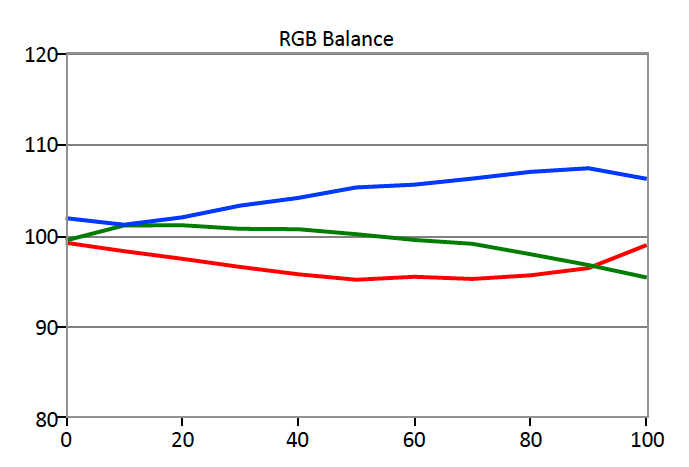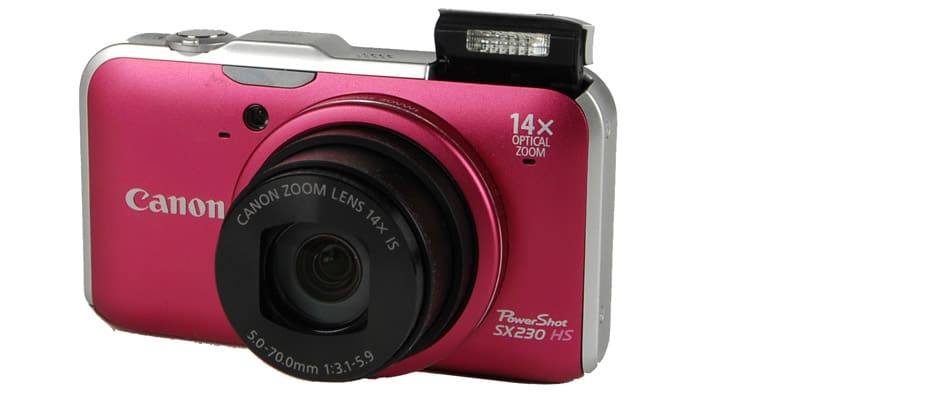Introduction
This camera benefits from optical image stabilization, predominantly physical controls, a 3-inch LCD, and a Digic IV processor allowing for full 1080p HD video capture. In such a compact frame, we worry that the 14x zoom will mean poor image quality, but only testing will determine the outcome. The SX230 HS is available in black, blue, and fuchsia (which Canon calls red) for a current MSRP of $299.
Design & Usability
{{section_header}}{{section.name}}{{/section_header}}
A whiz for beginners
The Canon SX230 HS ultimately is an attractive combination of depth of control and simplicity of operation, with a simple menu system that belies the wealth of control options available. The Canon SX230 HS is not the most compact long-zooming camera on the market, but it provides large keys, a physical mode dial, and other touches that aid usability. The controls are all clearly labeled and the in-camera menu system is legible and easy to navigate. There is also a handy quick menu, or Function Menu, as Canon calls it, and an oddly placed mode dial. The mode dial, usually on atop a camera, is much larger than normal and sits on the back of the device, housing 13 clearly marked settings. It requires a little bit of extra effort to move, but that's optimal, because it also doubles as a thumb-rest. The one part that we dislike is the rear control dial, which has assigned default uses (such as flash settings, self-timer, etc.), but lacks labels of any sort.
The Canon SX230 HS also includes some hints and tips on the main, 3-inch LCD. These tooltips often pop up when you've highlighted an option for more than a second, and just offer quick explanations of what various settings do. This includes main menu options as well as physical shooting modes. These tips can be turned off if desired.
{{photo_gallery "Front Photo", "Back Photo", "Sides Photo", "Top Photo", "Bottom Photo", "Lens Photo", "Lens Photo 2", "3D Lens Photo", "Media Photo", "Easy Mode Photo", "Manual Controls Photo 1", "Manual Controls Photo 2", "Zoom Photo", "Zoom Photo 2", "Ease of Use Photo", "Battery Photo", "LCD Photo 1", "LCD Photo 2", "EVF Photo 1", "EVF Photo 2", "Ports Photo 1", "Ports Photo 2", "Ports Photo 3", "Ports Photo 4", "Ports Photo 5", "Ports Photo 6", "Handling Photo 1", "Handling Photo 2", "Handling Photo 3", "Handling Photo 4", "Buttons Photo 1", "Buttons Photo 2", "Buttons Photo 3", "Box Photo"}}
Features
{{section_header}}{{section.name}}{{/section_header}}
$300 will buy you a host of extras and a big zoom on a little body.
The Canon SX230 includes a variety of extras, but perhaps the most obvious is the camera's built-in GPS functionality, which is usable in specific scenarios, though we didn't find it particularly engaging (or functional) in the city. The camera otherwise has a solid spec sheet with a 14x optical zoom lens, 120 and 240fps high-speed video shooting, and a full set of PASM exposure modes.
The Canon SX230 HS provides a number of automatic modes specifically geared toward novice shooters, as well as manual mode for the more experienced hand. There is a large variety of scene modes on hand, as well as Canon's "my colors" suite, which offers anything from vivid red to darker skin tone and beyond. A custom mode lets you make adjustments to things like contrast and saturation on a +/- 2 stop scale, and in-camera editing is limited to the basics.
Performance
{{section_header}}{{section.name}}{{/section_header}}
The zoom is doomed.
14x zoom sounds nice, but longer lenses have a tendency to detract from image quality. The SX230 follows this trend, capturing noisy, off-color, and distorted shots in most shooting scenarios. Some shots are wonderfully detailed, but at long zooms especially, image stabilization struggles and pictures become severely blurred. Noise reduction is rather ineffective, so that disruptive noise creeps in as early as ISO 200.
This performance lags well behind the competition. Further, and likely thanks to the ambitious lens, ugly fringing is very noticeable in the high contrast areas of all shots. These pink or yellow marks glow along the borders of dark edges, and the problem gets worse toward the edges of the frame. As for video, this camera offers full HD, but controls are limited and motion capturing struggles considerably, resulting in blurry, polluted footage.
Conclusion
{{section_header}}{{section.name}}{{/section_header}}
The SX230 is voted off the island.
At the time of this writing, the PowerShot SX230 HS has already been replaced by the SX260 HS. The newer model is $50 more, and we recommend either saving up the extra cash or, if you're a really thorough shopper, waiting until we finish our review of that camera too.
While there isn't much to love about the image quality of the SX230, sharpness is at least well above average, even if lackluster noise reduction spoils it. We also had fun using Canon's highly intuitive menu system, which made this a very painless camera to shoot with. Of course, decent resolution and a great interface can't make up a good camera alone. Sadly the SX230 has all the common pitfalls associated with extreme zoom lenses. Chromatic aberration is very severe, image stabilization is in over its head, and even color accuracy suffers for some reason. This model may be a breeze to use, but we just cannot recommend a camera with image quality of such a disappointing caliber.
Science Introduction
{{section_header}}{{section.name}}{{/section_header}}
The SX230's color and noise disappointed us. It's a shame, because the level of detail was at times impressive, but poor image stabilization and distortion drag everything down.
Image Quality
{{section_header}}{{section.name}}{{/section_header}}
Issues with color and distortion plague this camera's image quality.
Canon tends to be hit or miss when it comes to color accuracy, and the SX230 is a miss for sure. The smallest error value we could achieve was 3.82, quite a bit worse than average, even for a compact camera. Flesh tones were particularly far off, with many shades of yellow turning to green.
Most likely due to the ambitious lens, chromatic aberration is very noticeable in the high contrast areas of all shots. Fringing often manifests itself as pink or yellow glow bordering dark edges, and the problem only gets worse toward the edges of the frame.
Barrel distortion is very severe (over 1.00%) at the widest focal length, however this quickly tapers at the middle and end of the focal range. This results in an overall average of 0.12%, not too shabby.
{{photo_gallery "Science Section 1 Images"}}
Noise Reduction
{{section_header}}{{section.name}}{{/section_header}}
Noise reduction is rather ineffective.
The SX230's handling of noise is very poor. Image noise cracks a full 1.00% as early as ISO 200, and increases exponentially from there, finally reaching 1.83% at the maximum sensitivity. This score is quite a bit worse than many travel zooms on the market.
{{photo_gallery "Science Section 2 Images"}}
Image Stabilization
{{section_header}}{{section.name}}{{/section_header}}
Shots are detailed, but the image stabilizer struggles with long zoom shots.
Detail levels were above average with the SX230 HS, however our results swung wildly depending on the current focal length. Sometimes sharpness reached over 2200 MTF50s, which is quite good, but at longer focal lengths and regions closer to the edge of the frame, detail dropped below 800 MTF50s. Edges also have a tendency to become oversharpened, and this detracts from the realism of exposures. But overall, we're awarding a decent score here.
At the maximum zoom ratio, blurriness is quite severe. The SX230's optical stabilizer will create a relative improvement to sharpness, but in the grand scheme of things, even the stabilized image won't be very appealing. Our test is based on percent-improvement though, and this stabilizer does technically increase detail by 52% on average.
{{photo_gallery "Science Section 3 Images"}}
Video
{{section_header}}{{section.name}}{{/section_header}}
Movies are sharp enough, but artifacting and interference pollute the image.
Motion isn't great in videos captured with the SX230. There's a bit of jumpiness, some artifacting, and some blurriness to fast moving subjects. An option for a 60p frame rate would've gone a long way here. Resolution was also problematic. The SX230 HS was able to resolve only 450 LW/PH of detail horizontally and 550 vertically in our sharpness test, placing it far below the best performers in the category.

The AOC e2752She tends to over-emphasize blue within its sub-pixel balance.
Other Tests
{{photo_gallery "Other Tests Images"}}
Meet the tester
DigitalCameraInfo provides free independent camera news, features, buying guides, and reviews that help consumers make informed choices. Our reviews are grounded in a combination of real-world experience and unbiased, scientific testing. DigitalCameraInfo is part of the Reviewed.com network.
Checking our work.
Our team is here to help you buy the best stuff and love what you own. Our writers, editors, and experts obsess over the products we cover to make sure you're confident and satisfied. Have a different opinion about something we recommend? Email us and we'll compare notes.
Shoot us an email

